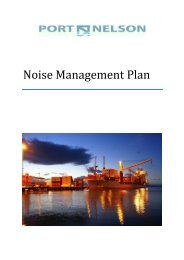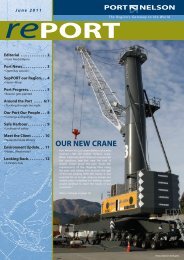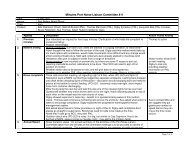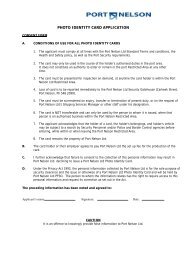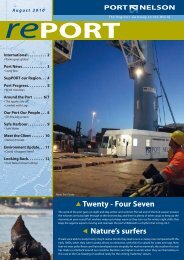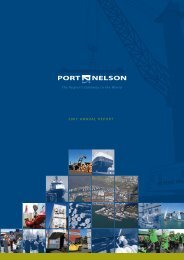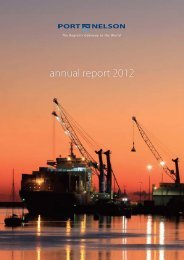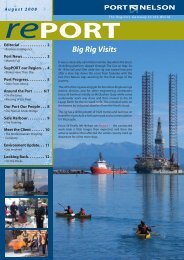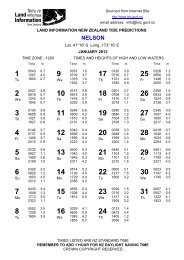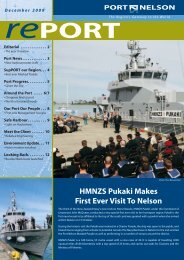April 2009 (pdf) - Port Nelson
April 2009 (pdf) - Port Nelson
April 2009 (pdf) - Port Nelson
Create successful ePaper yourself
Turn your PDF publications into a flip-book with our unique Google optimized e-Paper software.
Main Wharf South Infill<br />
A wharf is more than just the place you tie up a vessel – the<br />
area alongside for storage and cargo movement is just as<br />
vital for a speedy ship turnaround. For this reason we are<br />
embarking on the consent process to infill the area behind<br />
Main Wharf South. Brunt Quay will remain the preferred<br />
container berth but the development will lessen truck and<br />
forklift trips, improve crane efficiency and enhance safety.<br />
The expected cost of the development is in the vicinity of<br />
$3million, with the construction period taking 6-9 months.<br />
Cawthron is doing a report on the environmental impacts,<br />
but these are expected to be minimal, with the loss<br />
of seabed offset by the habitat provided by the new<br />
structure.<br />
We are consulting with Iwi, environment groups and<br />
residents and also seeking their views on a public amenity<br />
in the harbour area as part of the project. This could<br />
be a port education centre, a jetty at the lighthouse or<br />
some other facility that may come up as a result of the<br />
consultation.<br />
Supersize Shopping<br />
It’s dirty work but someone’s got to do it…we recently sent<br />
Andy Farmer from QuayPack and Grant Cottle from the<br />
Workshop to Aussie to have a look at new forklifts. When<br />
you’re spending over a million dollars it pays to get it right.<br />
The plans are for a 32 tonne Omega 36D, primarily for<br />
unloading timber packs into sheds, and a Hyster 18.00XMS for<br />
QuayPack. Unfortunately the recent drop in the NZ exchange<br />
rate has boosted the purchase price. The two new machines<br />
are expected to arrive mid-year.<br />
New Wharf in Use<br />
<strong>Port</strong> <strong>Nelson</strong> Limited report. <strong>April</strong> <strong>2009</strong>. Page 5<br />
The newly strengthened Main Wharf North has been busy recovering the $3.4 million cost of the upgrade, with ships<br />
berthed at this wharf more often as we enter our busy season. The wharf is proving itself for Tasman Bay Stevedores<br />
with both cranes now able to be worked, and more room for storage and hatch cover placement. Overall there’s less<br />
vehicle movement, we don’t have to shift the vessel along the berth during loading and we’re getting a faster vessel<br />
turnaround.<br />
The COSCO vessel Sils made good use of the enhanced MWN facility in March.<br />
More Washing Up<br />
There has been a noticeable increase in<br />
containers needing a wash, especially dry<br />
boxes. This is driven by demand for top grade<br />
units for wine and dairy product loadings,<br />
along with more ‘dirty’ import cargoes such<br />
as fertiliser, palm kernel and salmon food<br />
being shipped into <strong>Nelson</strong> in containers. This<br />
means our new wash pad, completed by<br />
contractors HEB Structures, is getting plenty<br />
of use. The wooden and concrete blocks have<br />
been replaced with a solid concrete surface<br />
that is easier to clean, an added biosecurity<br />
advantage. Forklift drivers say the new wash<br />
bay is much easier to work, with the added spin<br />
off of less stress on the hi-stacker spreaders.<br />
Forklifts Go Hi-Tech<br />
New Year is when <strong>Nelson</strong> Pine Industries has its<br />
annual maintenance shutdown, which provided<br />
us with a quiet time to implement the JADE<br />
warehousing systems at QuayPack. Supervisor,<br />
Andy Farmer reports the change has gone<br />
extremely well: “We now scan all product as it<br />
comes in by truck,” he explains. “Every pack is<br />
given a date, location and is assigned a vessel,<br />
so there’s no lost time in hunting for product.”<br />
All credit to the IT guys with their behind the<br />
scenes know-how and to the Quay Pack team<br />
for their enthusiastic upskilling.<br />
Paul Stent uses the long-range scanner mounted on his<br />
forklift to read the code on stacked MDF packs.<br />
port progress



